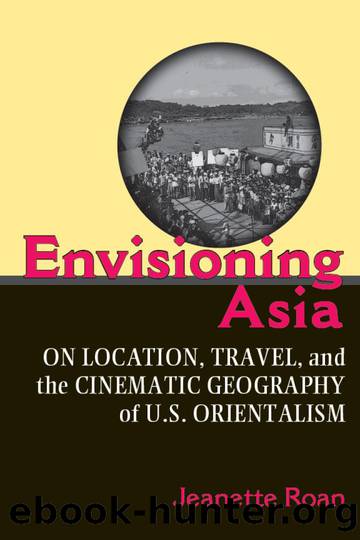Envisioning Asia by Roan Jeanette;

Author:Roan, Jeanette;
Language: eng
Format: epub
Publisher: University of Michigan Press
Teakwood tables, China temple dogs, gongs, dishes, water pots, wooden plows, matting, baskets of every nature, colored joss papers, Chinese water wheels, a Chinese windmill, Chinese bone needles, a Chinese sundial, Chinese toys, a wedding sedan chair, rickshas, doors, windows and other parts of buildings, Chinese idols, cooking utensils, both for rich and poor, chop sticks for rich and poor, rugs, two thousand costumes, pictures, bronzes, earthenware jars, etc.84
This list gives the impression of a Chinese community being uprooted in its entirety and transported across the Pacific; indeed, the re-created China in Chatsworth is uncannily reminiscent of the ethnographic villages at world's fairs and international expositions.
Ethnographic villages, initially popularized at the 1889 Paris Exposition Internationelle, were in significant evidence for the first time in the United States at the Chicago Columbian Exposition of 1893. These villages provide a precedent for the notion of importing authentic materials to the United States to reconstruct a faraway place, thereby bringing distant lives and cultures to U.S. audiences. The irony here is that MGM's efforts to re-create China in Chatsworth were, in a way, a return to a pro-tocinematic form that served as a model for the cinematic display of the spectacle of nonwhite Others.85 Like ethnographic villages, MGM's âChinaâ was created as a distillation of China, but unlike the earlier villages, it was intended from the start as a setting for a fictional narrative that would circulate on film. That is, rather than inviting Americans to travel to the Chatsworth site to witness the lives of the Chinese, as would have been the case in a world's fair, the filmmakers would stage for the camera the living of Chinese daily lives and the performance of their rituals; these images would then be circulated to audiences in their hometowns, for viewing at their local theaters. Like Burton Holmes, who viewed the exhibits of the 1893 Columbian Exposition as a way to travel the world within the fairgrounds and imagined his first illustrated travel lectures on Japan as an extension of and substitute for this virtual travel, MGM's film of The Good Earth was a way for U.S. audiences to see China and learn about the Chinese without leaving home.
The marvelous accomplishment of re-creating China in Chatsworth, however impressive in the way it used authentic Chinese crops and props, was still not quite complete. To truly come alive, this re-creation required inhabitants. World's fairs usually brought over ânativesâ to live in the ethnographic villages; for The Good Earth, two award-winning Austrian-born Hollywood stars were cast in the lead roles, supported by scores of Chinese American extras. Paul Muni, who portrayed Wang Lung, was an accomplished screen actor who became a star after playing the title role in Scarface (Howard Hawks, 1932) and won his first Academy Award for The Story of Louis Pasteur (William Dieterle, 1936). Luise Rainer, chosen for the role of O-lan, received an Oscar for her work in The Great Ziegfeld (Robert Z. Leonard, 1936). Although critics of the theatrical adaptation of
Download
This site does not store any files on its server. We only index and link to content provided by other sites. Please contact the content providers to delete copyright contents if any and email us, we'll remove relevant links or contents immediately.
The Kite Runner by Khaled Hosseini(4473)
Gerald's Game by Stephen King(3928)
The Perils of Being Moderately Famous by Soha Ali Khan(3791)
Dialogue by Robert McKee(3593)
Story: Substance, Structure, Style and the Principles of Screenwriting by Robert McKee(2992)
The 101 Dalmatians by Dodie Smith(2942)
The Pixar Touch by David A. Price(2744)
Confessions of a Video Vixen by Karrine Steffans(2681)
Fantastic Beasts: The Crimes of Grindelwald by J. K. Rowling(2550)
How Music Works by David Byrne(2536)
Slugfest by Reed Tucker(2424)
Harry Potter 4 - Harry Potter and The Goblet of Fire by J.K.Rowling(2420)
The Mental Game of Writing: How to Overcome Obstacles, Stay Creative and Productive, and Free Your Mind for Success by James Scott Bell(2398)
Wildflower by Drew Barrymore(2121)
Scandals of Classic Hollywood: Sex, Deviance, and Drama from the Golden Age of American Cinema by Anne Helen Petersen(2115)
Casting Might-Have-Beens: A Film by Film Directory of Actors Considered for Roles Given to Others by Mell Eila(2077)
Screenplay: The Foundations of Screenwriting by Syd Field(2064)
Robin by Dave Itzkoff(2010)
The Complete H. P. Lovecraft Reader by H.P. Lovecraft(1978)
